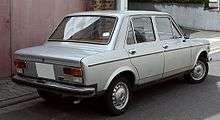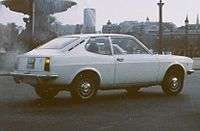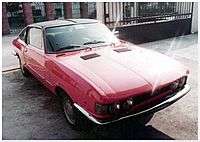Fiat 128
| Fiat 128 | |
|---|---|
|
| |
| Overview | |
| Manufacturer | Fiat |
| Also called |
Nasr 128 GLS 1300 SEAT 128 Zastava 128/101 |
| Production |
1969–1985 1980–2001 (Yugoslavia) |
| Assembly |
|
| Body and chassis | |
| Class | Small family car (C) |
| Body style | |
| Layout | Front-engine, front-wheel-drive |
| Related | Fiat X1/9 |
| Powertrain | |
| Engine | |
| Transmission | 4-speed manual |
| Dimensions | |
| Wheelbase | 2,445 mm (96.3 in) |
| Length | 3,850 mm (151.6 in) |
| Width | 1,590 mm (62.6 in) |
| Height | 1,340 mm (52.8 in) |
| Kerb weight | 750–770 kg (1,653–1,698 lb) |
| Chronology | |
| Predecessor | Fiat 1100 R |
| Successor | Fiat Ritmo |
The Fiat 128 is a tranverse front-engine, front wheel drive small family car manufactured and marketed by Fiat from 1969 to 1985 in body styles including two- and four-door sedan, three- and five-door station wagon as well as two- and three-door coupé. The 128 running gear and engine, reconfigured for a mid-engined layout, were used in the Fiat X1/9 sports car.
Named European Car of the Year in 1970,[4] over three million were manufactured.[5]
The 128 was noted for its innovative front-engine, front-drive layout, which enabled an especially large interior volume and ultimately became the predominant front engine/drive layout, worldwide.[6] In 2012, noted automotive journalist Jamie Kitman called the 128 a "pioneer of the small cars we drive today."[7]
Development
With engineering by Dante Giacosa and engine design by Aurelio Lampredi,[8] the 128 was noted for its relatively roomy passenger and cargo volume — enabled by a breakthrough innovation to the front-engine, front-drive layout which became the layout "adopted by virtually every other manufacturer in the world" for front-wheel drive.[6] Fiat promoted in its advertising that mechanical features consumed only 20% of the vehicle's volume and that Enzo Ferrari drove a 128 as his personal vehicle."[8]
Fiat built an entire new plant in Rivalta, north-west of Turin, specifically to manufacture the new 128.[9]
Front drive innovation

Front-wheel drive had previously been introduced to small, inexpensive cars with the British Mini. As engineered by Alec Issigonis, the compact arrangement located the transmission and engine sharing a single oil sump — despite disparate lubricating requirements — and had the engine's radiator mounted to the side of the engine, away from the flow of fresh air and drawing heated rather than cool air over the engine. The layout often required the engine be removed to service the clutch.[10]
As engineered by Dante Giacosa, the 128 featured a transverse-mounted engine with unequal length drive shafts and an innovative clutch release mechanism — an arrangement which Fiat had strategically tested on a previous production model for a full five years, the Primula from its less market-critical subsidiary, Autobianchi.[11] The layout enabled the engine and gearbox to be located side by side without sharing lubricating fluid while orienting an electrically controlled cooling fan toward fresh air flow. By using the Primula as a test-bed, Fiat was able to sufficiently resolve the layout's disadvantages, including uneven side-to-side power transmission, uneven tire wear and potential torque steer, the tendency for the power of the engine alone to steer the car under heavy acceleration.
The compact and efficient layout — a transversely-mounted engine with transmission mounted beside the engine driving the front wheels through an offset final-drive and unequal-length driveshafts — subsequently became common with competitors[8] and arguably an industry standard.[12]
The layout was sufficiently flexible that Fiat reconfigured the 128 drive-train as a mid-engined layout for the Fiat X1/9.
Design
The all new 1.1 litre Fiat SOHC engine, engineered by noted engine designer Aurelio Lampredi, featured an iron block mated to an aluminum head along with a belt-driven single overhead camshaft producing 49 hp.[8]
The 128 was styled similarly to the 124 and 125 and featured rack-and-pinion steering, front disc brakes, independent rear suspension with a transverse leaf spring, and a strut-type front suspension with integral anti-roll bar.[8]
Initially, the 128 was available as a two-door or four-door sedan. At the 1970 Turin Motor Show a three-door station wagon model called "Familiare" was added to the line-up.[9] The car was only available with a 1116 cc engine on launch, though the two-door-only 128 Rally edition launched in 1971 used a 1,290 cc unit. Also in 1971, the Sport Coupé, an all-new coupé body on a shortened 128 platform, was unveiled at the Turin Show. On launch it was available with both existing 128 engines.
The 128 range underwent a facelift in 1972, featuring a revised grille. 1974 saw the launch of the 128 Special, which used the Rally engine in a four-door sedan body. In 1975 the 128 3P (3-door) Berlinetta replaced the Sport Coupé. In 1976, the range received new bumpers, rectangular headlights, tail lights and dashboard as well as modifications to the engines. At this time, the wagon was also renamed the "Panorama".
Production of all 128s except that of the base 1,100 cc powered model ended in 1979 after the introduction of the Fiat Ritmo/Strada in 1978. In 1980 production of the small three-door station wagon Panorama was dropped from the range and 128 production finally ended in 1985.
Road test
The British "Motor" magazine tested a Fiat 128 in April 1970, shortly after its UK launch. The car had a top speed of 85.4 mph (137.4 km/h) and accelerated from 0-60 mph (97 km/h) in 15.5 seconds. An "overall" fuel consumption of 27.5 miles per imperial gallon (10.3 L/100 km; 22.9 mpg‑US) was recorded. This put it fractionally behind the contemporary Morris 1300 on maximum speed but usefully ahead on acceleration. The two were closely matched on fuel economy, where both were outrun by the Ford Escort 1300 Super also included in the comparison, here in its four-door version. The Fiat's £876 manufacturer's recommended price was not too far above the Morris 1300's £830 and the Escort's £838. The testers commended the Fiat's interior space and excellent performance. Wind and road noise were low, but engine noise was not.[13]
Variants
 Fiat 128 Familiare (3-door station wagon)
Fiat 128 Familiare (3-door station wagon) Fiat 128 Coupé SL
Fiat 128 Coupé SL Fiat 128 3P "Berlinetta" (3-door coupé)
Fiat 128 3P "Berlinetta" (3-door coupé)
128 Rally
| Fiat 128 Rally | |
|---|---|
 1972 Fiat 128 Rally | |
| Overview | |
| Production | 1971–74 |
| Dimensions | |
| Wheelbase | 2,448 mm (96.4 in)[14] |
| Length | 3,876 mm (152.6 in)[14] |
| Width | 1,590 mm (62.6 in)[14] |
| Height | 1,390 mm (54.7 in)[14] |
| Kerb weight | 820 kg (1,808 lb)[14] |
The Fiat 128 Rally was a sporty, 1.3-litre-engined version of the 128 two-door saloon, introduced at the 41st Geneva Motor Show in March 1971[15] and produced up to 1974.[16]
Compared to the regular 128's 1,116 cc four-cylinder engine, the Rally's type 128 AR engine had been bored out 6 mm to 86 mm—while keeping the 55.5 mm stroke—for a total displacement of 1,290 cc (79 cu in).[15] There was also twin-choke Weber 32 DMTR carburettor, revised valve timing and a slightly higher 8.9:1 compression ratio. Engine output was now 67 DIN-rated metric horsepower (49 kW; 66 hp) at 6,200 rpm and 88 DIN-rated newton metres (65 lb·ft) of torque at 4,000 rpm.[14] Other mechanical improvements were the addition of a vacuum servo, an engine protection plate, better tyres, new gear ratios for the 4-speed transmission, a higher capacity battery and an alternator in place of the dynamo).[14]
A number of exterior features set the Rally apart from other 128s. At the front there was a black radiator grille, carrying the round Fiat emblem typical of the marque's sports cars; split bumpers joined by a tubular steel bar; and halogen headlamps and bumper-mounted auxiliary lamps. At the rear dual round tail lamps replaced the square ones found on the regular two-door 128. "Rally" badging on the bonnet and booth lid and stripes along the side sills completed the look. The interior was upholstered in black leatherette, and the dashboard housed upgraded instrumentation: a tachometer was standard equipment, and water temperature and oil pressure gauges took the place of the ashtray, relocated to the centre console. Front sports seats with headrests and a two-spoke sports steering wheel replaced the standard items.[17]
In October 1972 Fiat introduced a several updates to the whole 128 saloon and Familiare range, including the 128 Rally. In particular the Rally received new upholstery (leatherette with cloth seat centres) and a black plastic protection to the front bumper tube.[16]
128 Coupé and 3P
| Fiat 128 Coupé | |
|---|---|
 1972 Fiat 128 Coupé SL 1100 | |
| Overview | |
| Production | 1971–75 |
| Dimensions | |
| Wheelbase | 2,223 mm (87.5 in)[18] |
| Length | 3,808 mm (149.9 in)[18] |
| Width | 1,560 mm (61.4 in)[18] |
| Height | 1,310 mm (51.6 in)[18] |
| Kerb weight | 810–820 kg (1,786–1,808 lb)[18] |
At the 53rd Turin Motor Show of November 1971 Fiat introduced the 128 Coupé, also called 128 Sport, a 2-door, 4-seat coupé based on a shortened 128 chassis.[19] It was produced until 1975, when it was replaced by the 3-door 128 3P.
The Coupé version was available with two different engines (1100 and 1300) and in two different trim levels (S and SL) for a total of four variants.[19] In its base "S" trim, the coupé had single rectangular front headlamps, and wheels and hubcaps from the saloon. The pricier "SL" (for Sport Lusso) was distinguished by quadruple round headlamps, a specific grille, steel sport wheels without hubcaps, chromed window surround trim, door handles and fuel cap, and black decorative striping along the sills and across the tail panel. Inside it gained a leatherette-wrapped steering wheels, perforated leatherette upholstery, extended four-gauge instrumentation, loop pile carpeting and black headlining.
The two engines were developed from the units found in the 128 saloon and 128 Rally respectively, and both were fitted with twin-choke carburettors and a two-piece exhaust manifold. The 1100 (1,116 cc) produced 64 PS DIN (47 kW; 63 hp) at 6,000 rpm and 81 N·m (60 lb·ft) at 3,800 rpm, while the 1300 (1,290 cc) produced 75 PS DIN (55 kW; 74 hp) at 6,600 rpm and 92 N·m (68 lb·ft) at 3,800 rpm.[18] Top speed was over 150 km/h (93 mph) and 160 km/h (99 mph) respectively.[18] Compared with the 128 saloon, the coupé had a 23 cm (9.1 in) shorter wheelbase (at 2,223 mm or 87.5 in),[19] and tracks 20 mm wider at the front and 45 mm narrower at the rear.[20] Suspension was the familiar all-independent 128 layout—save for the front anti-roll bar, which had been replaced by radius rods.[20] The braking system consisted of discs at the front and drums at the rear; it was made more efficient by fitting smaller diameter front discs and the front and the vacuum servo first used on the 128 Rally.[19]
Licensed production
The 128 formed the basis of the Zastava 128 (four-door sedan) and Zastava 101 (three-door and five-door hatchbacks) ranges of cars manufactured by the "Zastava Automobili" company in Serbia. The 128-based Zastavas were available throughout Europe in the '70s. In Britain, three variants were offered: a three-door hatchback (Zastava Yugo 311/313), four-door saloon (Zastava Yugo 411/413) and a five-door hatchback (Zastava Yugo 511/513). As one of the Serbian automaker's most affordable models, production ended in November 2008.
Zastava also produced the 128 in its original, four-door sedan form. Until 2009, CKD kits were manufactured by Egypt's Nasr car company as the Nasr 128.[1]
In Argentina, the 128 was produced from 1971 to 1990 as a four-door sedan or five-door wagon, the Fiat 128 Rural, the latter unique to Argentina. Several trims and versions were available, including the IAVA sport series. In 1983 the car received a facelift with new headlamps, tail lamps and front grille, which was marketed as the Super Europa. In Colombia, the 128 was produced by "Compañía Colombiana Automotriz" in Bogota.
In Spain, SEAT manufactured its own version of a 128 coupé, with its own bodywork. It was available with a 1200 or a 1,430 cc Fiat 124 engine and was later replaced by the 3P Berlinetta model (31,893 copies).
In Sri Lanka, the Fiat 128 was manufactured by the Upali Motor Company until 1978. For South Africa only, a pickup version was also developed by Fiat in Italy to contest that country's popular "bakkie" category. It entered production in 1978.[3] It could handle a payload of 500 kg (1,100 lb) and was based on the station wagon model. As per dealer demands, the fuel tank was enlarged to 52 L (13.7 US gal).[21]
 Fiat 128 Rural 5-door, Argentinian production
Fiat 128 Rural 5-door, Argentinian production- Fiat 128 Super Europa, manufactured between 1983–1990 by Sevel Argentina
 Rear view of 1988 Fiat Super Europa 1.3 (Argentina)
Rear view of 1988 Fiat Super Europa 1.3 (Argentina) Zastava 128
Zastava 128
Moretti 128
The Moretti Motor Company of Turin, Italy produced the Fiat 128-based Moretti 128 in coupé and cabriolet versions.[22]
 Moretti 128
Moretti 128
See also
References
Notes
- 1 2 "El Nasr closure spells end to long running assembly of Fiat 128 and 131 in Egypt". italiaspeed.com. Retrieved 21 May 2009.
- ↑ "Historique de la SOMACA". Somaca Casablanca. Retrieved 25 April 2010.
- 1 2 Wilkins, Gordon (September 1978). "Fiat: Italy's industrial giant". CAR (South Africa). Vol. 22 no. 8. Ramsay, Son & Parker (Pty) ltd. p. 67.
- ↑ "Previous Cars". Caroftheyear.org. Archived from the original on 13 December 2007. Retrieved 29 January 2008.
- ↑ "Fiat 128: quarant'anni di trazione anteriore" (in Italian). Autoblog.it. Retrieved 1 June 2012.
- 1 2 Brick by Brick: The Biography of the Man Who Really Made the Mini, Martyn Nutland, p. 237. Authorhouse, Bloomington, IN, 2012. ISBN 9781477203170.
- ↑ Kitman, Jamie (15 August 2012). "Collectible Classic: 1971–1979 Fiat 128". Automobile Magazine.
- 1 2 3 4 5 "Collectible Classic: 1971-1979 Fiat 128". Automobile Magazine, August 2012.
- 1 2 Becker, Clauspeter (1971), Logoz, Arthur, ed., "Fiat 128", Auto-Universum 1971 (in German), Zürich, Switzerland: Verlag Internationale Automobil-Parade AG, XIV: 88
- ↑ "Dante Giacosa". Fiat 500 USA.
- ↑ Becker, p. 79
- ↑ "1969-1984 FIAT 128 Saloon". Classic and Performance Car.
It’s the recipe for technical orthodoxy that has since been adopted by the entire industry.
- ↑ "Fiat 128 "Once more a winner"". The Motor: 23–28. 4 April 1970.
- 1 2 3 4 5 6 7 Fiat—Tutti i modelli del Novecento, pp. 26–27.
- 1 2 "La 128 Rally". Autosprint (in Italian). XI (9): 44. 1 March 1971.
- 1 2 Fiat—Tutti i modelli del Novecento, pp. 56.
- ↑ "Per una guida giovane la "128" versione rally" [For the young drivers, the "128" rally]. Stampa Sera (in Italian). 10 March 1971. p. 8. Retrieved 9 March 2017.
- 1 2 3 4 5 6 7 "I nuovi Coupé Fiat 128 veloci, economici, sicuri". La Stampa (in Italian). 6 November 1971. p. 20. Retrieved 8 February 2016.
- 1 2 3 4 Bernabò, Ferruccio (10 October 1971). "II nuovo Coupé Fiat 128 Sport". La Stampa (in Italian). p. 11. Retrieved 8 February 2016.
- 1 2 "Da sbalordire le 128 "esse"" [The astonishing 128 "S"]. Autosprint (in Italian). XI (48): 41. 26 November 1971.
- ↑ Wright, Cedric, ed. (August 1978). "Fiat 128-1300 half-ton pick-up". CAR (South Africa). Vol. 22 no. 7. Ramsay, Son & Parker (Pty) ltd. p. 55.
- ↑ "The Marketplace: Moretti 128 Cabriolet". theretromobilist.com. Retrieved 27 June 2015.
Bibliography
- Fiat—Tutti i modelli del Novecento. II. Editoriale Domus. 2010.
External links
| Wikimedia Commons has media related to Fiat 128. |
| « previous — Fiat car timeline, 1940s–1970s — next » | ||||||||||||||||||||||||||||||||||||||||||||||||||
|---|---|---|---|---|---|---|---|---|---|---|---|---|---|---|---|---|---|---|---|---|---|---|---|---|---|---|---|---|---|---|---|---|---|---|---|---|---|---|---|---|---|---|---|---|---|---|---|---|---|---|
| Type | 1940s | 1950s | 1960s | 1970s | ||||||||||||||||||||||||||||||||||||||||||||||
| 0 | 1 | 2 | 3 | 4 | 5 | 6 | 7 | 8 | 9 | 0 | 1 | 2 | 3 | 4 | 5 | 6 | 7 | 8 | 9 | 0 | 1 | 2 | 3 | 4 | 5 | 6 | 7 | 8 | 9 | 0 | 1 | 2 | 3 | 4 | 5 | 6 | 7 | 8 | 9 | |||||||||||
| City car | 500 "Topolino" | 500 | ||||||||||||||||||||||||||||||||||||||||||||||||
| 600 | 126 | |||||||||||||||||||||||||||||||||||||||||||||||||
| Supermini | 850 | 133 | ||||||||||||||||||||||||||||||||||||||||||||||||
| 127 | ||||||||||||||||||||||||||||||||||||||||||||||||||
| Small family car | 1100 (Type 103) | 128 | ||||||||||||||||||||||||||||||||||||||||||||||||
| 1100 A / B / E | 1200 Granluce | 124 | Ritmo | |||||||||||||||||||||||||||||||||||||||||||||||
| 131 | ||||||||||||||||||||||||||||||||||||||||||||||||||
| Large family car | 1400 | 1300 / 1500 | 132 | |||||||||||||||||||||||||||||||||||||||||||||||
| 1500 | 1900 | 125 | ||||||||||||||||||||||||||||||||||||||||||||||||
| Executive car | 1800 | |||||||||||||||||||||||||||||||||||||||||||||||||
| 2800 | 2100 | 2300 | 130 | |||||||||||||||||||||||||||||||||||||||||||||||
| Coupé | 850 Coupé | |||||||||||||||||||||||||||||||||||||||||||||||||
| 128 Coupé | 128 3P | |||||||||||||||||||||||||||||||||||||||||||||||||
| Pininfarina Coupé | 124 Sport Coupé | |||||||||||||||||||||||||||||||||||||||||||||||||
| 2300 Coupé | 130 Coupé | |||||||||||||||||||||||||||||||||||||||||||||||||
| Spider | 850 Spider | |||||||||||||||||||||||||||||||||||||||||||||||||
| 1100 | 1200 | Pininfarina Cabriolet | 124 Sport Spider | |||||||||||||||||||||||||||||||||||||||||||||||
| Sports car | 8V | Dino | ||||||||||||||||||||||||||||||||||||||||||||||||
| X1/9 | ||||||||||||||||||||||||||||||||||||||||||||||||||
| MPV | 600 Multipla | |||||||||||||||||||||||||||||||||||||||||||||||||
| Off-road | Campagnola (1101) | Campagnola (1107) | ||||||||||||||||||||||||||||||||||||||||||||||||